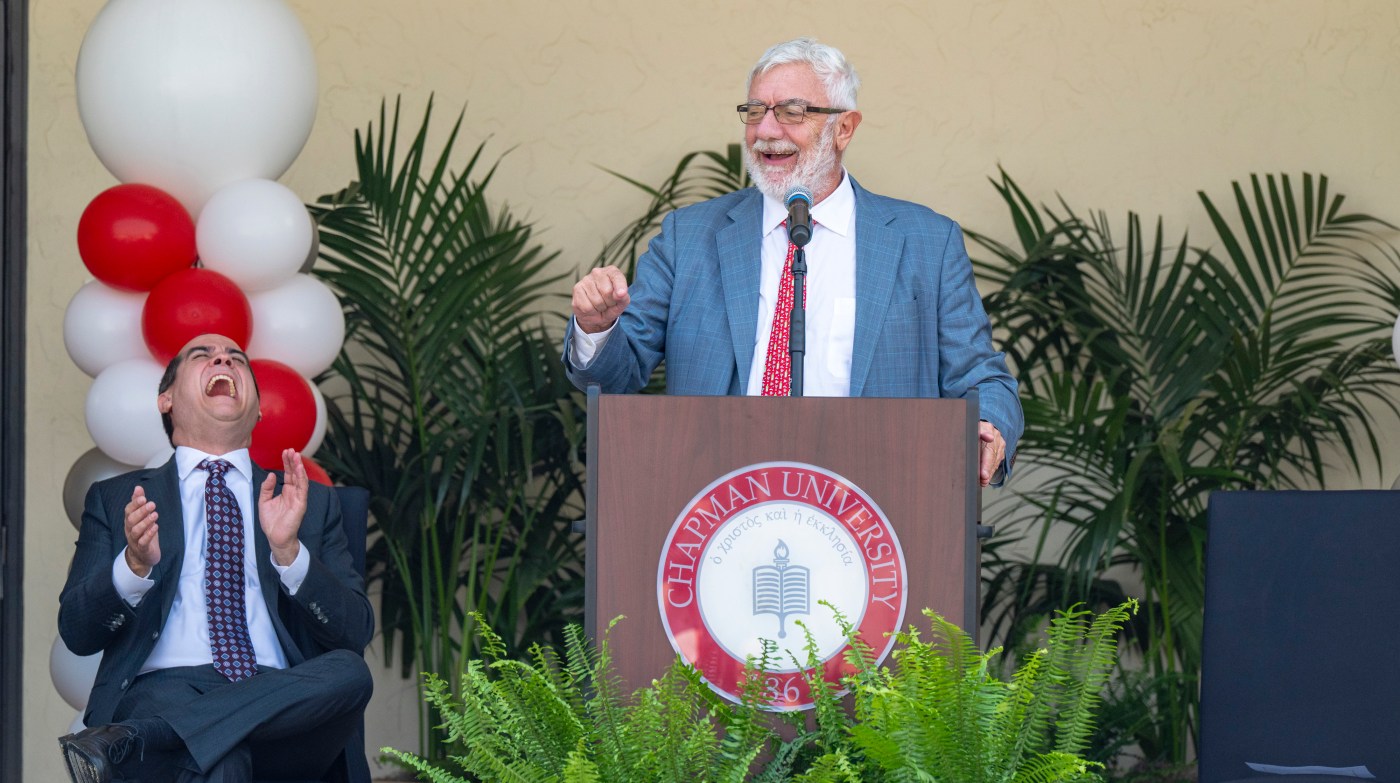Once shuttered and crumbling, the Lydia D. Killefer School is now home to some of Chapman University’s most ambitious scientific ventures. But the elementary school has its own history of taking ambitious steps, choosing in 1944 to voluntarily desegregate.
On Tuesday, Aug. 5, the university officially dedicated the renovated campus as the Daniele C. Struppa Research Park, a nod to the outgoing president who helped guide the university’s rise in research and academic stature. But the focus of the day, in many ways, remained on the building and its deep history, the care that went into bringing it back to life and its new purpose.
Built in 1931 in the Cypress Street Barrio for white students, Killefer holds a singular place in Orange County history. In 1944, long before court orders forced California schools to integrate, Killefer became one of the first schools in the state to integrate.
Nearly a century later, that same Orange campus is once again the setting for boundary-pushing work — this time in quantum science and research.
“Killefer was desegregated before they were forced to desegregate,” Chapman President Daniele Struppa said. “It’s a school that carries a very important symbolic meaning for the city and we are committed to continuing that.”
The Orange Unified School District’s decision to integrate the school in 1944 came three years before Mendez v. Westminster, a federal court case that outlawed segregation in California schools and laid the groundwork for Brown v. Board of Education nationally.
“I think the purpose of education is really to improve society,” Struppa said. “We need to be an agent of positive change for a better society. And there is never an end to that job. So to occupy a space that voluntarily desegregated, expressing a very specific intent on part of the principal, the teachers, the community to move forward in that way, is very symbolic for us.”
The school operated for decades before being shuttered in 1989. Chapman purchased the site in 2020 after several higher bidders walked away. When renovations began, the building had been vacant for nearly 20 years.
At the time, 64% of the windowpanes were broken, according to Colette Creppel, Chapman’s vice president of campus planning and design. The wood floors were in severe disrepair. Two aging portables sat jammed up against the building’s walls, one pressed up against a live oak tree in the courtyard.
“But we love challenges,” Creppel said. “And as they say, the bones were good, and the vision was strong.”
Now, one of the most storied properties in Orange will serve as the home of Chapman’s Institute for Quantum Studies and Advanced Physics Laboratory.
“Chapman is really rapidly improving in reputation and research activity,” said physics professor John Howell. “It’s just a wonderful time to be here at Chapman. It’s an excellent time to do physics. This is a place now that’s getting a worldwide reputation for its quantum foundations, for quantum computing, for quantum optics, for a host of really interesting projects that researchers are engaging in.”
Among the project’s restored features are Killefer’s original chalkboards, now reused and repurposed throughout the labs, Creppel said. Some were installed as blackboards in their original locations, others fashioned into writable walls for faculty and students.
Creppel said that at every step, her team worked to strike a careful balance between repurposing the building and preserving its original Spanish Colonial Revival character.
She said they restored the archways and left the courtyard breezeway untouched, replacing only a few doors, which still sit within their original frames. The octagonal bell tower still stands, with the original school bell perched atop the cupola.
A new entrance from Olive Street now leads to a restored historic lobby, updated for accessibility, and a semi-public community room.
Creppel said the colors and furniture were chosen to create a warm atmosphere, particularly in one conference room that was originally a theater. In the back of the room, dubbed “the treehouse,” an oversized nook features green beanbag-style chairs, an arched entryway and large windows that fill the space with natural light.
“It does make science feel more inviting,” she said.
Tuesday’s dedication also served to honor Struppa, who joined Chapman in 2006 and has served as president since 2016. Under his tenure, the university earned R2 Carnegie status for doing significant research and invested heavily in state-of-the-art facilities, including the $130 million Keck Center for Science and Engineering.
“I’ve done so many unveilings, so many openings of buildings,” Struppa said. “It feels a little odd to open a building with my name.”
He said he told incoming president Matt Parlow he didn’t want “any hoopla,” and that he preferred to leave quietly, like a “thief in the night.”
“Now, today’s event shows you how incapable (Parlow) is of following orders,” Struppa joked, drawing laughter.
Parlow said the name was chosen not for vanity, but because it reflected what Struppa’s leadership had helped embed in the university’s identity.
“It really captured one of the many legacies that Daniele leaves from both his leadership as chancellor and president, in really upping our academic excellence and really imbuing in the fabric of Chapman University this real dedication to research,” Parlow said.
He also noted the naming was a playful twist on real estate language.
“For those of you who know real estate, the term research park is actually a term in real estate to describe a certain kind of property,” Parlow said. “But for here, it’s a playoff of words. Here, we do research in this park-like setting.”








